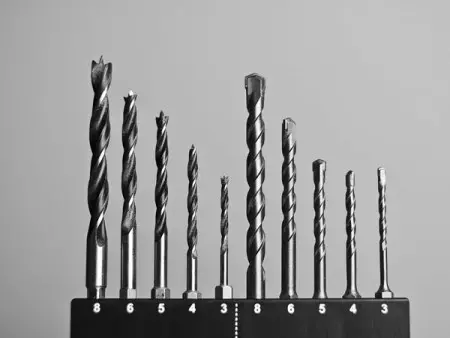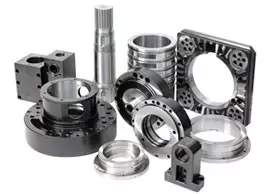SCM440
Alloy Steel
SCM440 is medium carbon chromium molybdenum alloy steel, which is an alloy steel containing chromium and molybdenum. It has the advantages of stable composition, low harmful elements, high steel purity, small decarburization layer and few surface defects. It is easy to be spheroidized and has low cold cracking rate. It is usually hardened and tempered. The ultimate tensile strength is 850-1000 Mpa. This material achieves a very good balance between strength, toughness and wear resistance. The chromium content of the alloy provides good hardness permeability, and the molybdenum element imparts average hardness and high strength.
SCM440 reacts well in heat treatment and it is easy to process under heat treatment conditions. This material provides many desirable properties such as good strength and wear resistance, excellent toughness, good ductility and resistance to high-temperature stresses.
Chrome alloy structure steel
Purpose
SCM440 are widely used in high toughness alloy structural steel.
Product Features:
1. High strength and toughness.
2. Great property of quenching and can be deep hardened.
3. Less tempering brittleness tendency.
4. Great machining performance under high temperature and nice appearance after machining.
5. Good performance in weld ability.
6. Excellent performance in impact absorption, such as where the hammer may bounce back and has barely any damage caused upon impact.
International Comparison of Materials
| EU EN | INTER ISO | USA AISI | JAPAN JIS | GERMANY DIN | CHINA GB | FRANCE AFNOR |
|---|---|---|---|---|---|---|
| 42CrMoS4 42CrMo4 | 42CrMo4 | 4140 4142 | SCM440 | 42CrMo4 | 42CrMo | 42CD4 42CD4u |
| ITALY UNI | SPAIN UNE | Sweden SS | Finland SFS | Russia GOST | England BS |
|---|---|---|---|---|---|
| 42CrMo4 | 40CrMo41 40CrMo4 F1252 | 2244 | 42CrMo4 | 35KHM 38KHM | 708M40 CFS11 |
**This comparison table is for reference only. The standards and grades of various countries have slightly different chemical compositions. Please refer to the database for details.**
Chemical Composition(JIS G4051)
| C(%) | Si(%) | Mn(%) | P(%) | S(%) | Cr(%) | Mo(%) | Ni(%) | Cu(%) |
|---|---|---|---|---|---|---|---|---|
| 0.38-0.43 | 0.15-0.35 | 0.6-0.85 | 0≦0.03 | 0≦0.03 | 0.9-1.2 | 0.15-0.3 | 0≦0.25 | 0≦0.3 |
Conditions of heat treatment
- Annealing: 830℃ Furnace Cooling
- Normalization: 830~880℃ Air Cooling
- Hardening: 830~880℃ Oil Cooling
- Tempering: 530~630℃ Rapid Cooling
Criterion for heat treating conditions revise:
- Ac: 750~790℃
- Ar: 740~690℃
- Ms: 310℃
Mechanical properties
Tensile strength (kgf/mm²): ≧100
Yield strength (kgf/mm²): ≧85
Elongation (%): ≧12
Cross section reduction rate (%): ≧45
Impact value (J/cm2): ≧6
Hardness (Hb) : 285~352
Size Range
| Shape | Size(mm) | |||||||||||
|---|---|---|---|---|---|---|---|---|---|---|---|---|
| Round Bar | 13 | 14 | 15 | 16 | 17 | 18 | 19 | 20 | 21 | 22 | 24 | 25 |
| 26 | 28 | 30 | 32 | 34 | 36 | 38 | 40 | 42 | 44 | 45 | 46 | |
| 48 | 50 | 55 | 60 | 65 | 70 | 75 | 85 | 90 | 95 | 100 | 105 | |
| 110 | 115 | 120 | 130 | 135 | 140 | 145 | 150 | 160 | 170 | 180 | 190 | |
| 200 | 210 | 220 | 230 | 240 | 250 | 260 | 270 | 280 | 290 | 300 | 315 | |
| 325 | 335 | 345 | 355 | 365 | 375 | 385 | 395 | 405 | 415 | 425 | 435 | |
| 445 | 455 | 465 | 475 | 485 | 495 | 505 | 515 | 525 | 535 | 545 | 555 | |
| 565 | 575 | 585 | 595 | 605 | ||||||||
- Steel Application

Gear
There are many types of gears, such as: spur gears, sprocket gears, timing pulleys, helical gears, internal gears, racks, spur bevel gears, curved bevel gears, zero-degree bevel gears, staggered spiral gears, worm gears, Halberd gear. The material of the gear must have strong bending fatigue strength and contact fatigue strength, and the tooth surface must have sufficient hardness and wear resistance, and the core must have a certain strength and toughness.The materials for gear application that we recommend are as below.

Machine Tool Spindle
There may be several spindles in a machine. There are many types of spindles, including grinding spindles, electric spindles, low-speed spindles, high-speed spindles, engraving machine spindles, milling machine spindles, lathe spindles, etc. Therefore, the spindle should be made of materials with the highest stability, rigidity and efficiency.The materials for machine tool spindle application that we recommend are as below.

Drive Shafts
In order to allow changes in the alignment and distance between the driving and driven components, the drive shaft contains one or more universal joints and couplings. Therefore, their materials must withstand strong pressure, while avoiding excessive additional weight to increase reverse inertia. The materials of drive shaft we recommend are as below.The materials for drive shaft application that we recommend are as below.

Bearing Shaft
There must be a shaft in the motor, which is mainly used to drive the motor and generate kinetic energy for other devices.The materials for bearing shaft application that we recommend are as below.

Cutting Tools
There are many types of cutting tools, such as: milling cutters, drills, circular saw blades, reamers, PCD (Polycrystalline Diamond) cutting tools, hole drills, lathe tools, stamping tools, etc. The quality of the cutting tool material will affect the surface quality, cutting efficiency, tool life and other factors. Therefore, the selected tool material should have a high degree of hardness, wear resistance, strength, toughness and heat resistance.The materials for cutting tools application that we recommend are as below.

Worm Shafts
When the worm wheel is running, it will generate a lot of heat energy due to contact friction. When the contact surface pressure is too high, coupled with high temperature, it is easy to cause wear on the tooth surface. Therefore, the worm rod should be made of wear-resistant and rigid materials.The materials for worm shaft application that we recommend are as below.

Machine Parts
The material types of mechanical parts include metallic materials, non-metallic materials and composite materials. Metal materials are divided into ferrous metal materials and non-ferrous metal materials. Ferrous metal materials include steel, cast steels and cast irons, which have good mechanical properties (such as strength, ductility, toughness, etc.), and are relatively cheap and easy to obtain. Non-ferrous metal materials have the advantages of low density, good thermal and electrical conductivity.The materials for machining parts application that we recommend are as below.




